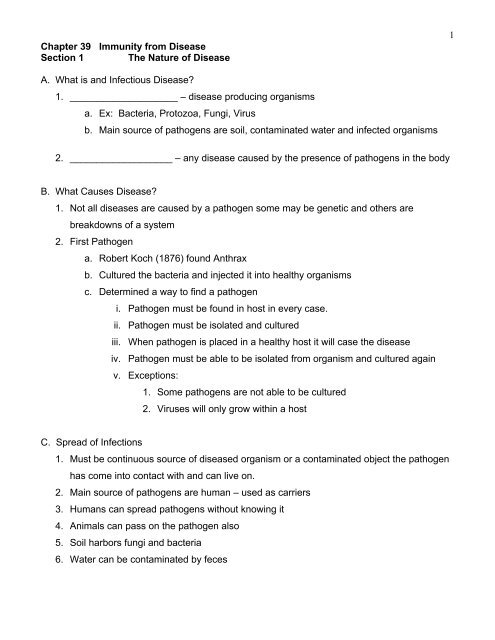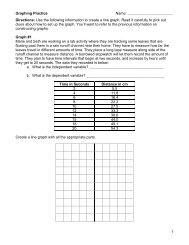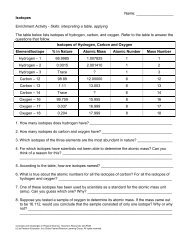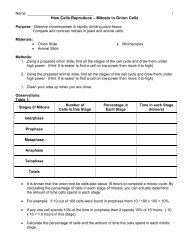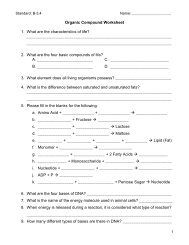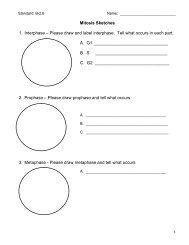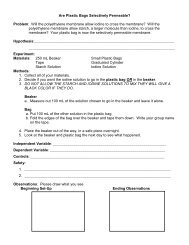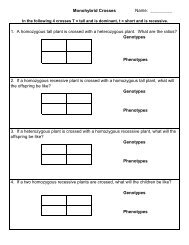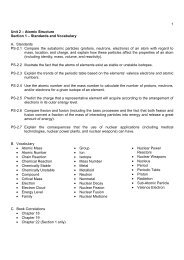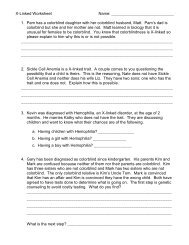Chapter 39
Chapter 39
Chapter 39
You also want an ePaper? Increase the reach of your titles
YUMPU automatically turns print PDFs into web optimized ePapers that Google loves.
<strong>Chapter</strong> <strong>39</strong> Immunity from Disease<br />
Section 1 The Nature of Disease<br />
1<br />
A. What is and Infectious Disease?<br />
1. ____________________ – disease producing organisms<br />
a. Ex: Bacteria, Protozoa, Fungi, Virus<br />
b. Main source of pathogens are soil, contaminated water and infected organisms<br />
2. ___________________ – any disease caused by the presence of pathogens in the body<br />
B. What Causes Disease?<br />
1. Not all diseases are caused by a pathogen some may be genetic and others are<br />
breakdowns of a system<br />
2. First Pathogen<br />
a. Robert Koch (1876) found Anthrax<br />
b. Cultured the bacteria and injected it into healthy organisms<br />
c. Determined a way to find a pathogen<br />
i. Pathogen must be found in host in every case.<br />
ii. Pathogen must be isolated and cultured<br />
iii. When pathogen is placed in a healthy host it will case the disease<br />
iv. Pathogen must be able to be isolated from organism and cultured again<br />
v. Exceptions:<br />
1. Some pathogens are not able to be cultured<br />
2. Viruses will only grow within a host<br />
C. Spread of Infections<br />
1. Must be continuous source of diseased organism or a contaminated object the pathogen<br />
has come into contact with and can live on.<br />
2. Main source of pathogens are human – used as carriers<br />
3. Humans can spread pathogens without knowing it<br />
4. Animals can pass on the pathogen also<br />
5. Soil harbors fungi and bacteria<br />
6. Water can be contaminated by feces
D. Transmission of Disease<br />
1. Direct Contact<br />
a. ___________<br />
b. ___________<br />
2. Through the Air<br />
a. ___________<br />
3. Intermediate Organism (Vector)<br />
a. ___________<br />
b. ___________<br />
c. Ex: Bubonic Plague<br />
c. ___________<br />
d. ___________<br />
2<br />
E. What causes the Symptoms of Disease?<br />
1. Pathogen runs into your immune system. If it beats your immune system it continues into<br />
the rest of your body<br />
2. Pathogens produce toxins, which are poisonous to the body. Pathogens can interrupt<br />
protein synthesis or destroy cells.<br />
a. Ex: ______ – destroys nerve cells and causes an increase in muscle contractions<br />
F. Patterns of Disease<br />
1. Disease can spread rapidly<br />
a. _________________<br />
b. _________________<br />
c. _________________<br />
2. CDC<br />
a. Tries to keep up with diseases and trends<br />
3. Outbreaks<br />
a. Occurs periodically and usually due to someone traveling to a foreign city<br />
4. Endemic Disease<br />
a. Many people in one are affected in a short period of time<br />
i. Ex: Flu
G. Treating Diseases<br />
1. Antibiotics work by inhibiting the growth and development of micro-organisms<br />
2. Viruses are immune to antibiotics – virus must run its course<br />
3. Antibiotic Resistance occurs when bacteria mutates<br />
4. Body’s built in immune system<br />
3<br />
<strong>Chapter</strong> <strong>39</strong> Immunity from Disease<br />
Section 2 Defense Against Infectious Disease<br />
A. ____________________________<br />
• Your skin is the line of defense your body has against pathogens<br />
o Maintains homeostasis<br />
o Absorbs fats from the digestive system<br />
o Helps the body defend itself<br />
1. _________________ – Physical Barrier to Micro-organisms<br />
2. _________________ – Trap Micro-organisms<br />
a. Mucus<br />
b. Sweat<br />
c. Tears<br />
d. Saliva<br />
3. _________________ – type of WBC’s that eat pathogens by engulfing them<br />
4. _________________<br />
a. Redness<br />
b. Swelling<br />
c. Pain<br />
d. Heat<br />
5. _________________ – group of proteins that attach themselves to the pathogen and<br />
help destroy them by attracting phagocytes<br />
6. _________________ – host specific defense and helps to make antiviral proteins<br />
B. Acquired Immunity<br />
1. When your body is invaded your immune system immediately starts to react.<br />
2. When you become ill, your body “remembers” and recognizes other diseases.<br />
3. This may take days or weeks but this is why you may be sick only a few days or a few<br />
weeks.
4<br />
C. Lymphatic System<br />
1. Cells of the body are bathed in fluid. The liquid picks up wastes and takes it to the<br />
lymphatic vessels to be disposed of through the veins.<br />
2. The lymph vessels pass through the lymph nodes and lymphocytes. The white blood<br />
cells defend against disease<br />
3. _________________ – large groups of lymph nodes on the back of the throat<br />
4. _________________ – filters and cleans the blood<br />
5. _______ – lymph organ – lymphocytes mature and differentiate into specific fighting cells<br />
D. Antibody Immunity<br />
1. Immune system recognize substances as self or non-self<br />
2. When the body recognizes a foreign substance it produces specific lymphocytes when<br />
then produces specific antibodies<br />
3. Antigens are found on surfaces of proteins. When a foreign antigen appears. When a<br />
foreign antigen appears antibodies are produced to fight them.<br />
a. __________ – cell produces in bone marrow and processed in the thymus gland<br />
b. __________ – lymphocyte that produces antibodies when activated by one of the<br />
t-cells<br />
E. Cellular Immunity<br />
1. T-cells binds to antigens<br />
a. Helper T-cell stimulates killer T cell<br />
b. Killer T-cell produces memory T-cells to react next time<br />
F. Immunity from Disease<br />
1. ________________________<br />
a. Develops as a result of acquiring antibodies<br />
b. Natural Immunity - Mom gives antibodies to the child through milk or the placenta<br />
c. Artificial Immunity – inject antibodies in from someone or something immune to the<br />
pathogens (Vaccine)<br />
2. ________________________<br />
a. Develops as a result of exposure to the antigen<br />
b. Memory cells are then produced to react to pathogen next time<br />
G. AIDS and the Immune System<br />
1. _______________ – Human Immunodeficiency Virus<br />
2. _______________ – Acquired Immunodeficiency Syndrome


